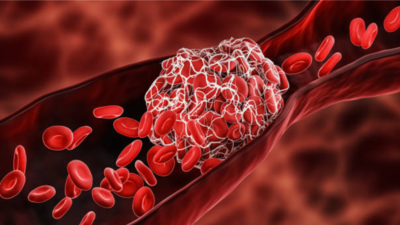- News
- lifestyle
- health-fitness
- health-news
- Which is the most common body part to get a blood clot (why is it so and how to avoid this)
Trending
Which is the most common body part to get a blood clot (why is it so and how to avoid this)
Blood clots, or thrombosis, especially in the legs (DVT), pose serious health risks. Extended inactivity, trauma, medical conditions, and hormonal factors are key contributors. Taller people have a greater risk due to increased venous surface area. Signs like leg swelling and pain need immediate attention. Preventive measures include regular exercise, hydration, managing chronic conditions, and possibly anticoagulants for high-risk individuals.
Blood clots, medically known as thrombosis, can occur in various parts of the body. These are small gel-like masses that control bleeding and internally they stop the flow of blood leading to life threatening situations.
The most common site is the deep veins of the legs. This condition, called Deep Vein Thrombosis (DVT), can have serious health implications if not promptly diagnosed and treated. It happens when the blood in the veins does not move fast enough.
Why are legs prone to clots?
Extended periods of inactivity, such as long flights, bed rest, or sedentary lifestyles, can slow blood flow in the legs, increasing the risk of clotting. Trauma to the legs or surgical procedures can damage blood vessels, triggering the body’s clotting mechanism as a natural response to injury.
Cancer, heart disease, obesity, and certain autoimmune disorders can elevate clotting risks, especially in the lower extremities. Pregnancy, hormone replacement therapy, and birth control pills can increase clotting risks due to elevated estrogen levels, affecting leg veins more prominently.
Do taller people have a higher risk of having blood clots in the legs?
Another study published in 2017 in the journal Circulation: Cardiovascular Genetics had also found a link between blood clot and height. The researchers found that men whose height was under 5 foot 3 inches had a 65 percent lower risk of VTE compared with men who were 6 foot 2 inches or taller.
Seek medical help when you see these signs
- Sudden swelling, pain, or redness in the leg
- Shortness of breath
- Chest pain, especially when breathing deeply
- Rapid heartbeat
How to prevent blood clot in the legs
- Regular physical activity enhances blood flow. Aim for at least 30 minutes of moderate exercise daily.
- Take short walks or stretch every hour during long flights, car rides, or desk work.
- Adequate hydration maintains blood viscosity, reducing clot risk.
- These can improve circulation in the legs, especially for those with a history of DVT or during long travel.
- Obesity increases pressure on veins, elevating clot risk.
- Control diabetes, hypertension, and heart disease through medication and lifestyle changes.
- Smoking damages blood vessels and increases clotting risks.
- For high-risk individuals, anticoagulants like warfarin or newer agents (DOACs) may be prescribed.
- Genetic predisposition requires proactive management and consultation with healthcare providers.
End of Article
FOLLOW US ON SOCIAL MEDIA
Visual Stories
Tired of too many ads?go ad free now











